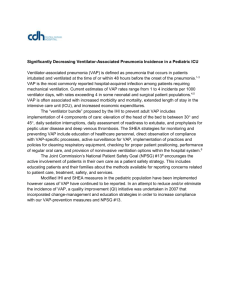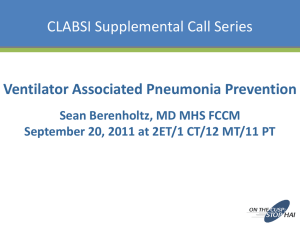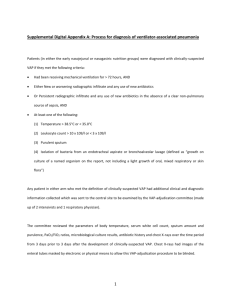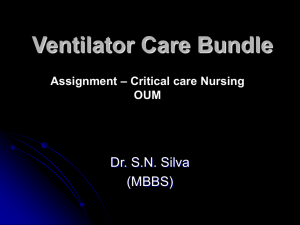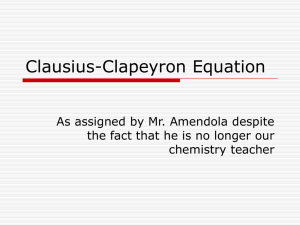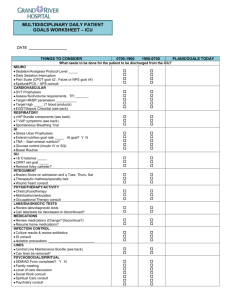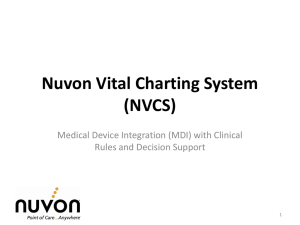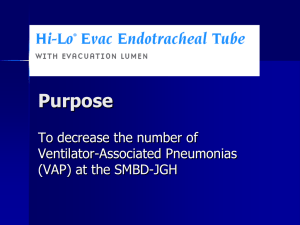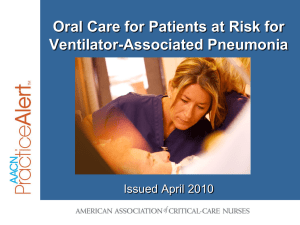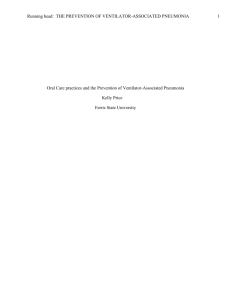original article the microbiological profile of ventilator
advertisement
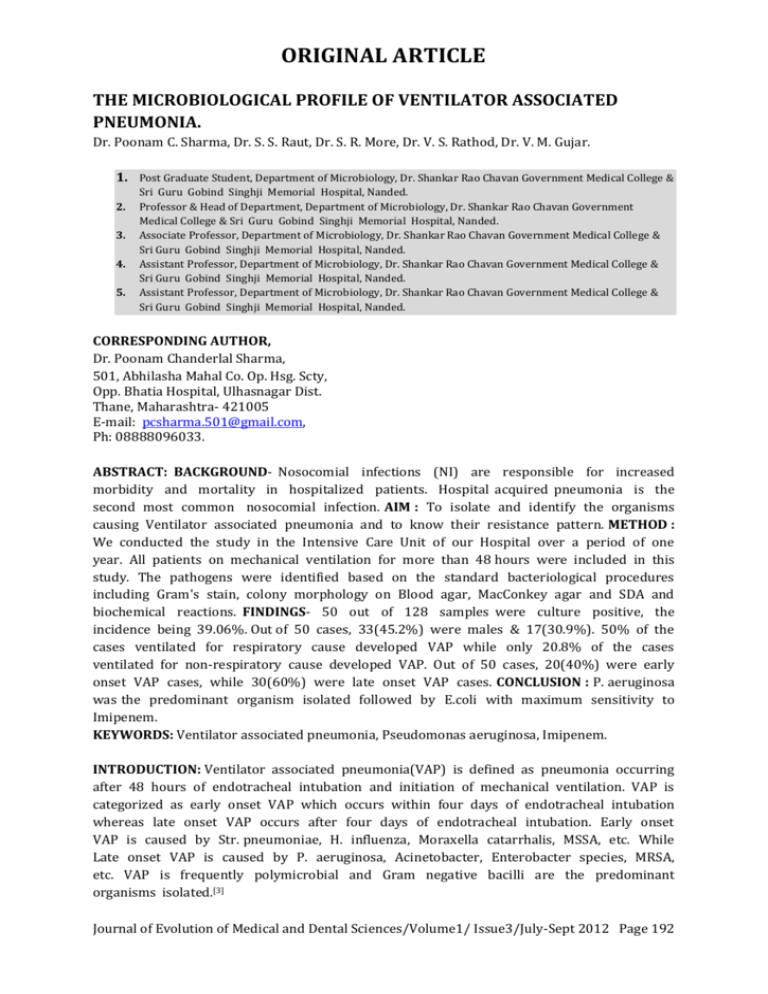
ORIGINAL ARTICLE THE MICROBIOLOGICAL PROFILE OF VENTILATOR ASSOCIATED PNEUMONIA. Dr. Poonam C. Sharma, Dr. S. S. Raut, Dr. S. R. More, Dr. V. S. Rathod, Dr. V. M. Gujar. 1. Post Graduate Student, Department of Microbiology, Dr. Shankar Rao Chavan Government Medical College & 2. 3. 4. 5. Sri Guru Gobind Singhji Memorial Hospital, Nanded. Professor & Head of Department, Department of Microbiology, Dr. Shankar Rao Chavan Government Medical College & Sri Guru Gobind Singhji Memorial Hospital, Nanded. Associate Professor, Department of Microbiology, Dr. Shankar Rao Chavan Government Medical College & Sri Guru Gobind Singhji Memorial Hospital, Nanded. Assistant Professor, Department of Microbiology, Dr. Shankar Rao Chavan Government Medical College & Sri Guru Gobind Singhji Memorial Hospital, Nanded. Assistant Professor, Department of Microbiology, Dr. Shankar Rao Chavan Government Medical College & Sri Guru Gobind Singhji Memorial Hospital, Nanded. CORRESPONDING AUTHOR, Dr. Poonam Chanderlal Sharma, 501, Abhilasha Mahal Co. Op. Hsg. Scty, Opp. Bhatia Hospital, Ulhasnagar Dist. Thane, Maharashtra- 421005 E-mail: pcsharma.501@gmail.com, Ph: 08888096033. ABSTRACT: BACKGROUND- Nosocomial infections (NI) are responsible for increased morbidity and mortality in hospitalized patients. Hospital acquired pneumonia is the second most common nosocomial infection. AIM : To isolate and identify the organisms causing Ventilator associated pneumonia and to know their resistance pattern. METHOD : We conducted the study in the Intensive Care Unit of our Hospital over a period of one year. All patients on mechanical ventilation for more than 48 hours were included in this study. The pathogens were identified based on the standard bacteriological procedures including Gram's stain, colony morphology on Blood agar, MacConkey agar and SDA and biochemical reactions. FINDINGS- 50 out of 128 samples were culture positive, the incidence being 39.06%. Out of 50 cases, 33(45.2%) were males & 17(30.9%). 50% of the cases ventilated for respiratory cause developed VAP while only 20.8% of the cases ventilated for non-respiratory cause developed VAP. Out of 50 cases, 20(40%) were early onset VAP cases, while 30(60%) were late onset VAP cases. CONCLUSION : P. aeruginosa was the predominant organism isolated followed by E.coli with maximum sensitivity to Imipenem. KEYWORDS: Ventilator associated pneumonia, Pseudomonas aeruginosa, Imipenem. INTRODUCTION: Ventilator associated pneumonia(VAP) is defined as pneumonia occurring after 48 hours of endotracheal intubation and initiation of mechanical ventilation. VAP is categorized as early onset VAP which occurs within four days of endotracheal intubation whereas late onset VAP occurs after four days of endotracheal intubation. Early onset VAP is caused by Str. pneumoniae, H. influenza, Moraxella catarrhalis, MSSA, etc. While Late onset VAP is caused by P. aeruginosa, Acinetobacter, Enterobacter species, MRSA, etc. VAP is frequently polymicrobial and Gram negative bacilli are the predominant organisms isolated.[3] Journal of Evolution of Medical and Dental Sciences/Volume1/ Issue3/July-Sept 2012 Page 192 ORIGINAL ARTICLE CLINICAL DIAGNOSTIC CRITERIA FOR VAP ARE: Clinical suspicion of pneumonia with a new or progressive chest radiographic infiltrates after 48 hours of patient’s mechanical ventilation and one of the following Fever >38.3oC Leukocytosis > 12000/cmm or leukopenia < 4000/cmm Purulent respiratory secretions with gram stain demonstration of bacteria and polymorphs CULTURES WITH GROWTH : >105 cfu/ml [3] AIM: To isolate and identify the organisms causing Ventilator associated pneumonia and to know their resistance pattern. METHODS: SETTING AND SUBJECTS: We conducted the study in the Intensive Care Unit of our hospital over a period of one year from 1st July 2011 to 30th June 2012. All patients on mechanical ventilation for more than 48 hours were included in this study. Patients with pneumonia prior to mechanical ventilation or within 48 hours of mechanical ventilation were excluded. STUDY DESIGN AND DATA COLLECTION: From each patient the following data was collected- Name, age, sex, primary diagnosis, date of admission in the hospital and ICU. The patients fulfilling both the clinical and microbiological criteria were diagnosed to be suffering from VAP. Microbiological criteria included positive Gram stain (>10 polymorphonuclear cells/ low power field and ≥1 bacteria/ oil immersion field with or without the presence of intracellular bacteria). Clinical criteria included modified Clinical Pulmonary Infection Score (CPIS) > 6 Journal of Evolution of Medical and Dental Sciences/Volume1/ Issue3/July-Sept 2012 Page 193 ORIGINAL ARTICLE IDENIFICATION OF VAP PATHOGENS: The pathogens were identified based on the standard bacteriological procedures including- Gram’s stain - Colony morphology on Blood agar , MacConkey agar and SDA - Biochemical reactions. [10] FINDINGS INCIDENCE: 50 out of 128 samples were culture positive, the incidence being 39.06% Characterisics of the patientsIncidence in males and females- Table I Incidence differences due to various causes of ventilation- Table II Incidence due to early onset and late onset pneumonia- Table III DISCUSSION: The incidence of VAP in our study was 39.06% which was similar to a study conducted by Shalini et. al.(35.78%) and Rakshit et. al.[4][8] In males incidence of VAP was 45.2% and that in females was 30.9% which was similar to the study conducted by Gadani et. al.[11] 40% of cases were early onset VAP and 60% were late onset VAP which tallies to other studies conducted by Chastre et. al. and Kollef et. al. [5][6] Incidence in patients ventilated for respiratory cause was 50% and that due to nonrespiratory cause was 20.83%, which co-relates to the study conducted by Akash Deep et. al.[7] Pseudomonas was the predominant organism in our study (31.48%) similar to that conducted by Joseph et. al. (21.3%) and Gadani et. al. (43.24%)[9][11] CONCLUSION: Pseudomonas aeruginosa was the predominant micro organism isolated with maximum resistance to Tobramycin. E. coli was the second most common micro organism with maximum resistance to Ampicillin. While both were 100% sensitive to Imipenem. Microbiologial surveillance facilitates the monitoring of changes of dominant micro- organisms and antibiotic susceptibilities helping in the decision of empirical treatment regimes and as a result, selecting the right antibiotics. ACKNOWLEDGEMENTS : Staff of Microbiology Department and Medicine Department, Study patients. FUNDING: None TABLE I: Gender No. of VAP cases No. of cases in whom VAP absent Total no. of cases Male 33 (45.2%) 40 (54.8%) 73 (100%) Female 17 (30.9%) 38 (69.1%) 55 (100%) Χ2 =2.69 P value > 0.1 (not significant) Journal of Evolution of Medical and Dental Sciences/Volume1/ Issue3/July-Sept 2012 Page 194 ORIGINAL ARTICLE TABLE II Cause of ventilation No. of VAP cases No. of cases in whom VAP absent Total no. of cases Respiratory cause 40 (50%) 40 (50%) 80 (100%) Non respiratory cause 10 (20.8%) 38 (79.2%) 48 (100%) Χ2 =10.72 P value <0.01 (highly significant) TABLE III Duration of ventilation No. of VAP cases Total no. of cases Early onset 20 (40%) 50 (100%) Late onset 30 (60%) 50 (100%) Χ2 =4 P value < 0.05 (significant) FIGURE 1 Causative Agents- 35.00% 31.48% 30.00% 25.00% 20.00% 15.00% 10.00% 5.00% 16.67% 14.81% 12.96% 9.26% 3.70% 1.85% 1.85% 1.85% 1.85% 3.70% 0.00% Journal of Evolution of Medical and Dental Sciences/Volume1/ Issue3/July-Sept 2012 Page 195 ORIGINAL ARTICLE FIGURE 2 Resistance Pattern of P. aeruginosa- 60% 50% 48% 40% 33% 30% 26% 22% 20% 10% 5% 0% 0% FIGURE 3 Resistance Pattern of E. coli 100% 95% 90% 80% 67% 70% 60% 50% 50% 50% 40% 30% 20% 20% 10% 0% 0% Ampicillin Cefazolin Tobramycin Amikacin Gentamicin Imipenem CONFLICT OF INTEREST: None Journal of Evolution of Medical and Dental Sciences/Volume1/ Issue3/July-Sept 2012 Page 196 ORIGINAL ARTICLE REFERENCES: 1) Steven M. Koenig and Jonathon D. Truwit Ventilator-Associated Pneumonia: Diagnosis, Treatment, and Prevention. PubMed Central Clin Microbiol Rev. October 2006; 19(4): 637–657. 2 ) Bailey & Scott’s Diagnostic Microbiology Eleventh Edition, Mosby Inc. Betty A. Forbes, Daniel F. Sahm, Alice S. Weissfeld ISBN 0-323-01678-2 3) Girish L. Dandagi Nosocomial pneumonia in critically ill patients Lung India Jul-Sep 2010; 27(3) 4) Rakshit P, Nagar V S, Deshpande A K Incidence, clinical outcome, and risk stratification of ventilator-associated pneumonia- a prospective cohort study. Indian J Crit Care Med 2005 9(4): 211-216 5) Chastre J and Fagon J Y Ventilator associated pneumonia. Am J Respir Crit Care Med 2002 165: 867-903. 6) Kollef M H Ventilator-associated pneumonia. A multivariate analysis. JAMA 1993; 270: 1965-1970. 7) Akash Deep, R. Ghildiyal, S. Kandian and N. Shinkre Clinical and Microbiological Profile of Nosocomial infection in the PICU. Indian Pediatrics 2004 41: 1238-1246 8) Shalini S, Kranthi K, Gopalkrishna Bhat K Microbiological profile of infections in ICU. J of Clinical and Diagnostic Research 2010 4: 3109-3112 9) Noyal Mariya Joseph, Sujatha Sistla, Tarun Kumar Dutta, Ashok Shankar Badhe, Subhash Chandra Parija. Incidence and risk factors of VAP. J Infect Dev Ctries 2009 3(10): 771-777 10) Mackie & McCartney Practical Medical Microbiology. J. G. Collee, A. G. Fraser, B. P. Marmion, A. Simmons. Churchill Livingstone, Fourteenth Edition, ISBN 0 443 049068 11) Gadani H, Vyas A, Kar A K. A study of ventilator-associated pneumonia: Incidence, outcome, risk factors and measures to be taken for prevention. Indian J Anaesth 2010; 54:535-40. Journal of Evolution of Medical and Dental Sciences/Volume1/ Issue3/July-Sept 2012 Page 197
